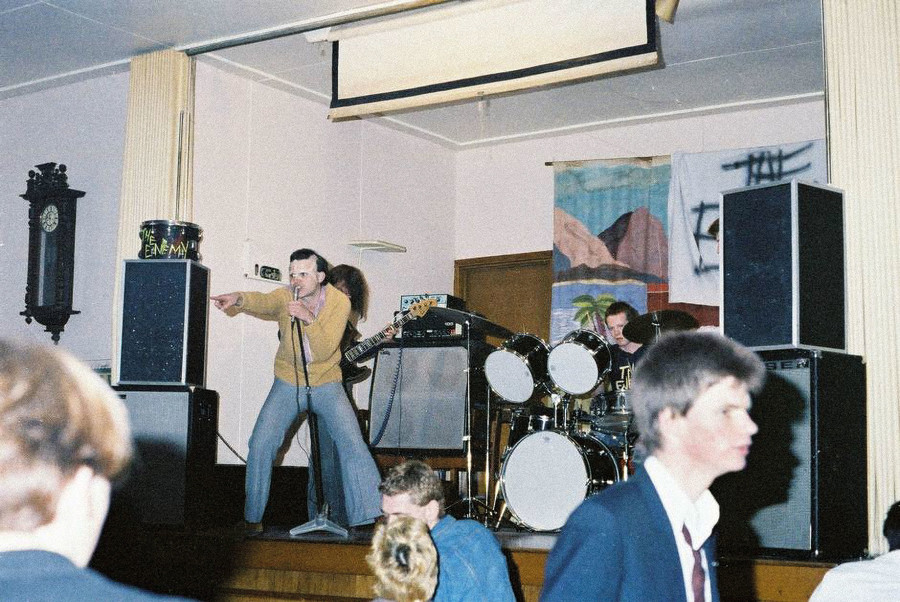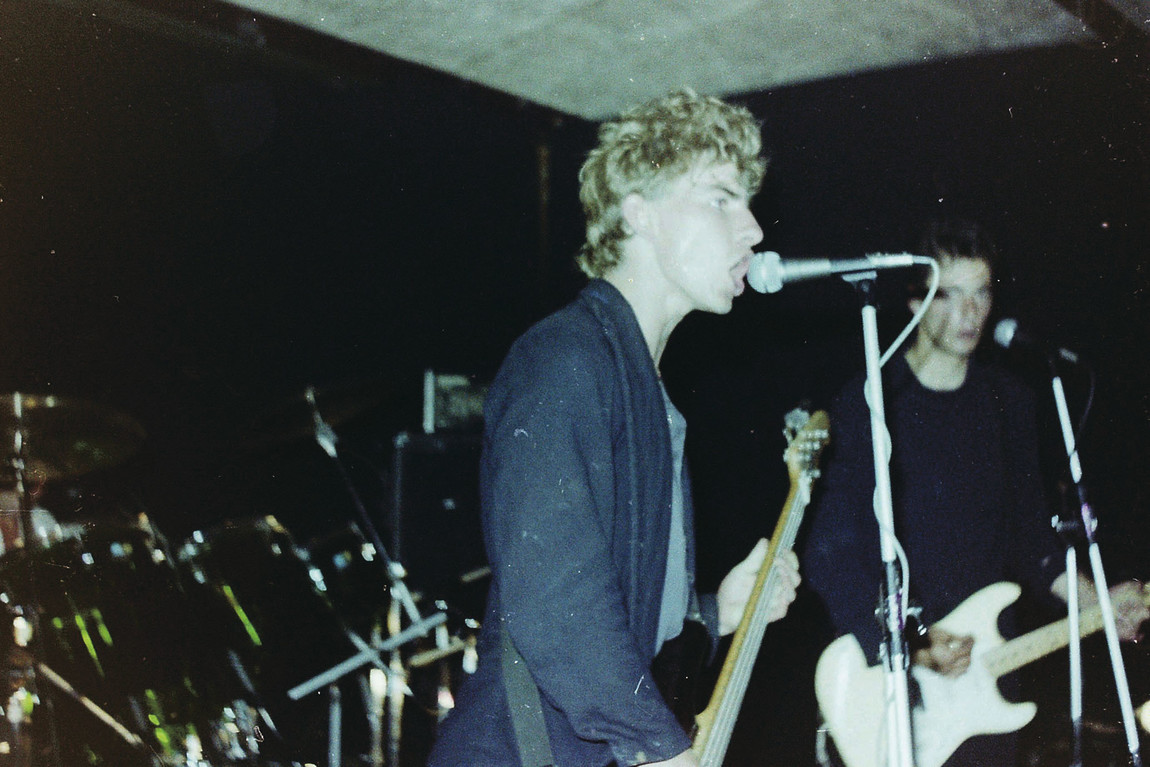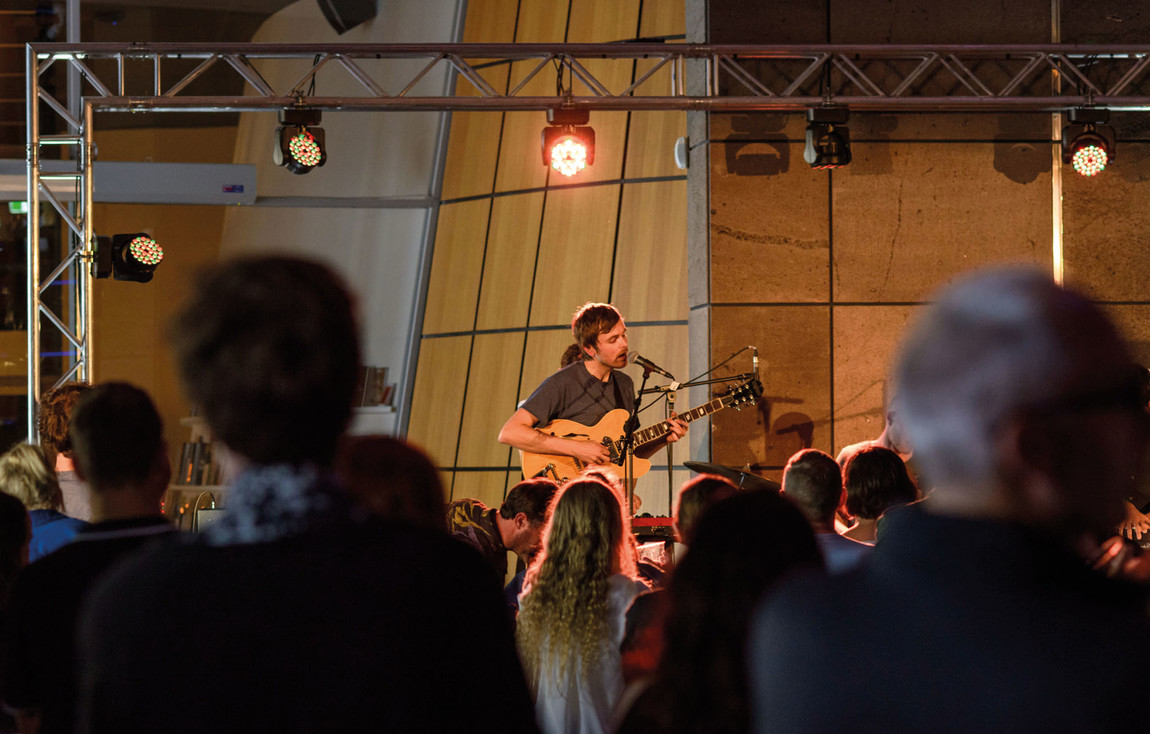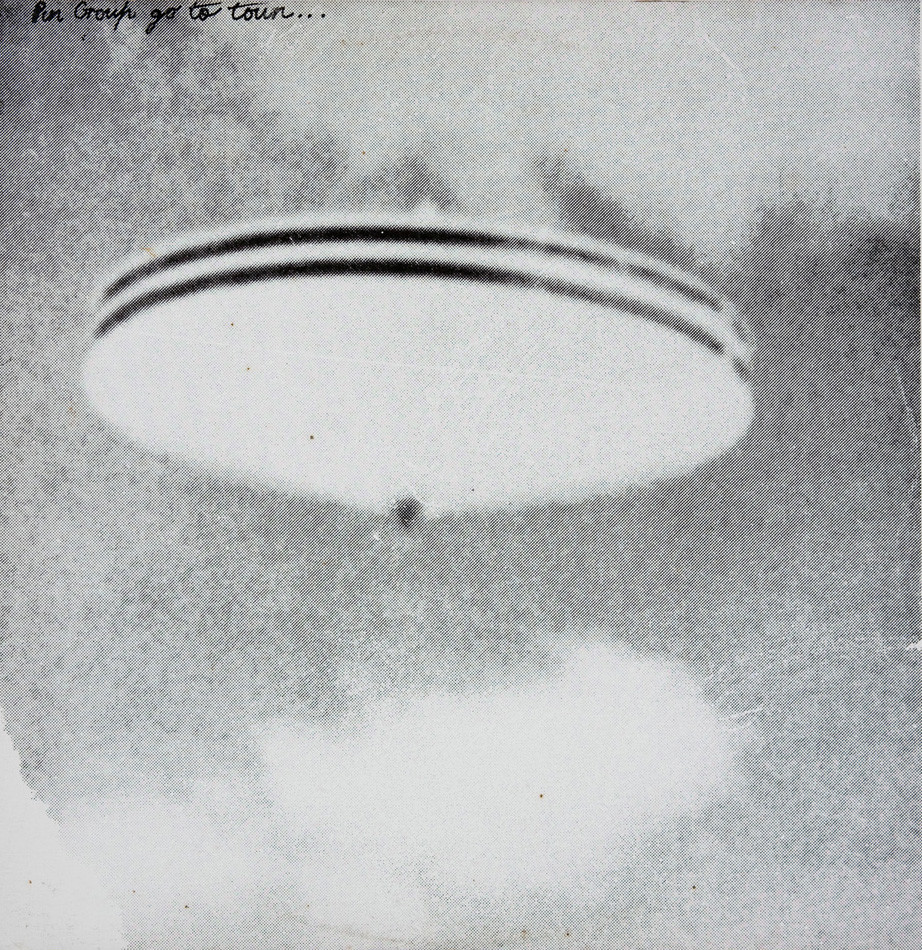The Christchurch Sound
This piece for Bulletin, the magazine of the Christchurch Art Gallery, was written to accompany their 2021 exhibition Hellazpoppin'! The Art of Flying Nun. It is a meditation on the unsung parallels between the Christchurch and Dunedin rock music scenes that inspired my PhD on South Island rock music culture, which was completed through the University of Otago in 2021.
The Christchurch Sound
A Revisionist History

Jeff Batts, The Enemy, Roger Shepherd in the
foreground. Beneficiaries Hall, Dunedin, 1978.
Photograph. Collection of Jeff Batts, Dunedin
A particularly romantic image attached to the record label Flying Nun shortly after its inception in 1981: journalists claimed it captured the purity of musicians playing without regard for fame or fortune. The label’s output became collectively known as the Dunedin Sound and formed the basis of a reputation that has shrouded Dunedin in classic rock mythology and mystery for the last forty years.
“Must be something in the water,” a 1992 Chicago Tribune article marvelled of Dunedin.1 “Perhaps more good musicians per capita than anywhere else in the world,” speculated the Guardian in its 2014 obituary of Peter Gutteridge.2 In the 2016 book The Dunedin Sound: Some Disenchanted Evening, Graeme Downes of The Verlaines repeats and echoes what the Chicago Tribune said nearly twenty-five years later: “We all have to scratch our heads and ask: How did this happen in a town of 120,000?”3 There is an increasingly blurred line where international attention and repetition have legitimised Dunedin as the “cultural centre” of New Zealand rock music.4 Although some academics have criticised this association, others merely repeat it.
Upon relocating from Dunedin to Christchurch ten years ago, I was intrigued to find a parallel rock music scene. I embarked on a PhD covering forty years of South Island rock music history, determined to give Christchurch its rightful place in the narrative. In the process of gathering forty-six oral histories from Christchurch and Dunedin musicians who had played between 1978 and 2018, I learned what joined the cities together as well as what had become a defining point of difference between Christchurch and Dunedin since their early days in tandem.
First, let us go back to when Christchurch and Dunedin were on fairly equal footing. Both had accumulated early wealth and then been left behind after the Panama Canal opened in 1914 and the boat traffic started going to Auckland instead. By the late 1970s, the dilapidated mansions with cracked floorboards that remained as reminders of both towns’ once glorious pasts had been taken over by musicians making a post-punk rock ruckus. Musicians and artists between the two cities shared cars, guitars and couches. Musicians from both Christchurch and Dunedin, seeking greener pastures, often left.
The story of the South Island rock music culture that produced Flying Nun is a spatial history of movement between towns. The flat stretch of highway that connects Christchurch and Dunedin remains unnoticed in the stories written by those on the North Island or overseas and is too obvious for those living on the South Island to point out. Yet the connection has been overlooked to the exclusion of Christchurch, and Dunedin is accepted as Flying Nun’s “spiritual home”.5
For some reason no one has said it yet, so I will: Dunedin acquired its rock reputation by siphoning off Christchurch’s capital and claiming all the credit.

Gordon Bartram The Gordons live at the Gladstone 1980. Photograph. Collection of Gordon Bartram
Consider the structural requirements that popular music scholars Gibson and Connell have set out for a music scene to exist. In order for someone with a guitar to become a rock legend, they need (1) a ‘critical mass’ of active musicians or fans, (2) recording and performance spaces, (3) record labels, and (4) distribution outlets.6
Dunedin rock musician David Kilgour of The Clean told The Otago Daily Times in 2006 that Dunedin did not feel ideal in the late 1970s: “It was hard times, folks. We had to leave the city to find any real, caring, supportive audience.”7 Chris Knox of The Enemy told Craig Robertson that Dunedin “was an incredibly depressing place to be after a while and we couldn’t afford to be anywhere else, couldn’t think of anywhere else to be”.8 Shayne Carter of Straitjacket Fits attributed the musical style in Dunedin to there being “no technology” and “no money”.9 Yet records are not made out of thin air or water: they cost money.
Flying Nun founder Roger Shepherd was a record store manager in Christchurch in 1981 who wanted to capture the sounds of the local bands that he watched “develop and then break up without ever recording or releasing a record.”10 Three years later, Rob Mayes was inspired to start the Christchurch record label Failsafe after being frustrated by being unable to buy any Newtones records after being awestruck at a gig.
It was the physical and financial labour of Christchurch rock music fans that turned the existence of a handful of gigging South Island rock musicians into a full-blown music scene. But the Dunedin narrative of musicians on the dole “thrashing away in their sheds”, to quote Martin Phillipps of The Chills, conveniently ignores that fact, because the need for cold hard cash to run a rock scene is not a romantic story.11 Nor is it romantic to get up in the morning and get paid by the man in order to press records. It’s not cool to care about money. But the act of running a record label implies a slight bent towards a commercial imperative.

Jeremy Freeman DoubleHappys sound check, Empire Hotel, Dunedin 1984. Photograph. Collection of Jeremy Freeman, Dunedin
Where the tale turns is what happened next. Journalists began telling tales of the rock musicians in Dunedin because isolation makes for a more iconic story. What had been a balanced exchange between the two cities – musicians who made music mostly at home – became attributed only to Dunedin, which subsequently became a symbol of David and his guitar alone at the bottom of the world giving the middle finger to the corporatised Goliaths of the West.
I need to ring the Chicago Tribune and the Guardian and report on my findings to their likely hypothetical question: Why are there so many Dunedin musicians? It’s because the Dunedin Sound became a siren call as rock musicians from all over New Zealand who also claimed a lack of interest in commercial success moved down to Dunedin. The French sociologist Pierre Bourdieu claims that one of the benefits of those who profess that they possess “legitimate culture” is “the supplementary profit of being seen (and seeing themselves) as perfectly disinterested, unblemished by any cynical or mercenary use of culture”.12 For rock musicians, one’s city of choice is a signal of disposition. Dunedin is a signifier of turning one’s back on capitalism in favour of the more noble pursuit of focusing on music instead. Rock musicians of a certain disposition congregate in Dunedin to cut their teeth, be around legends, join their friends.
Meanwhile, Christchurch carried on quietly, built by those who grew up and stayed, migrated from the upper half of the South Island, or were lucky enough to stumble across and fall in love with the scene while visiting. Its rock music scene has endured the bleed of those leaving to seek bigger things, whether to be surrounded by more musicians in Dunedin or to make their name in bigger cities, and often never returning. Christchurch does not have the siren call of a rock reputation to generate inward migration like Dunedin does. Had the narrative of the twin towns’ rock scenes been more balanced from the outset, their fates might have been different.

Grayson Gilmour live at Christchurch Art Gallery, 2017. Photo: John Collie
If perfect disinterest in success defines a Dunedin rock musician, the cross to bear of the Christchurch musician is to remain calm, productive and resilient, despite having one’s reputation stolen and hard work miscredited. If Christchurch had an ethos, it would be pragmatism: the musicians who live here prefer life on the South Island, but they value work, too. Those who contribute to the creation and preservation of rock music in Christchurch are interested and make no bones about it. There is nothing perfect about disinterest. Someone needs to pick up the cheque. A band may have formed in Dunedin. But if a tree falls in the woods and no one is around to hear it, it doesn’t make a sound. A new hypothetical question is needed to replace the platitude about Dunedin’s magical qualities: If a Dunedin band played in a forest but no one with a job was around to record it, would anyone in London give a shit? Would rock musicians still make pilgrimages towards the Kilmog hills, seeking to join them?
There were more findings from my PhD: the combination of free time and perfect disinterest is a fallacy. From far away, a town full of broke rock musicians might make for a romantic rock story, but up close, the reality is heartbreaking. The picture of a starving artist is enjoyable for everyone but the artist, who lives without security. Too much belief and life lived in accordance with the rock myth has a dark side and a sadness. Glorifying the lifestyle risks masking mental illness. Living on the bones of your ass feels different at 49 than it may have seemed at 17. Some perceive this intuitively. Others live it. In contrast, money buys comfort and jobs provide stability, which might not be a romantic story, but it makes for a better life – and in the long run, more productivity. A comfortable artist has potential for longevity.
Knowing someone with a car or crossing paths on the street has always been harder in Christchurch, a city with sprawling wide streets and besieged by earthquakes. Communication and meeting up require planning ahead and travelling great distances. Christchurch’s rock music scene is all the more remarkable because of this fact: it takes more effort, and yet that effort is made time and time again.

Doprah live at Christchurch Art Gallery, 2016. Photo: John Collie
There are two ways to have a productive rock scene. One is to be a mecca for people who want to make music more than they want to work; in this scenario it doesn’t matter if people burn out and leave because new ones are constantly arriving. The second is to be a place where musicians value work and make more music over a longer period because they have longevity. The Christchurch and Dunedin music scenes have the same beating heart: the ongoing participation of older musicians who have remained productive over time within a scene small enough that they not are only admired by, but familiar to, the younger bands.
The machine that drove Flying Nun is still in Christchurch: people pouring their heart, soul, time and energy into the production of rock music because they want to be a part of it. But the charming stories of gluing cardboard record sleeves are gone – for that outfit, anyway. They are not non-existent, however. You just need to know where to look. Record stores are limited; everything is on Bandcamp. Start with the record label Melted Ice Cream – established in 2011 by Joe Sampson and now run by Brian Feary – which Radio New Zealand placed as third in the lineage behind Flying Nun and Failsafe. CocoMuse Releases is another Christchurch outfit that has put out quality vinyl of underground Christchurch and Dunedin bands as of late.
Despite what the common platitudes about the South Island music scene in the 1980s may claim, rock music culture is not egalitarian, and the musicians were not all friends. Bourdieu focused his concept of social capital on not only who you know but the power of what you know and how you act: this was cultural capital, and it had value, too. Social and cultural capital explain how resources are exchanged among those perceived as holding value other than money. One way of dishonouring the exchanges that formed was to take without request, remorse or credit.
So when you visit the Hellzapoppin’! exhibition, here are some starting places for your mind to wander from: Where did they live? Did they change cities? When? Did they leave the South Island in search of bigger things? Or did they go all in and move to Dunedin? What are they doing now? Did they keep the balance? How well did the artist know the band? Were they flatmates? Lovers? Friends? Did the relationship last? Was the artist paid? How much? Was it promised but never happened? Do they still think it was worth it?
When at the exhibition, stay present. You might be mistaken for thinking the Christchurch rock music scene is something long gone and past, but don’t forget to look around you. What about that person next to you? Are they a rock musician, too?
Ian Chapman, The Dunedin Sound: Some Disenchanted Evening, Auckland: Bateman Publishing, 2016, p.7.
4.5.Grant McDougall, ‘From Humble Start, Flying Nun Soared’, Otago Daily Times, 5 July 2001, p.8.
6.7.‘Quarter of a Century and She Still Flies’, Otago Daily Times, 2 December 2006, p.59.
8.9.10.11.Martin Phillipps, interviewed by Hannah Herchenbach, 19 June 2015, Dunedin, New Zealand.
12.Pierre Bourdieu, Distinction, London: Routledge, 1984, p.79.















